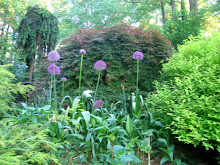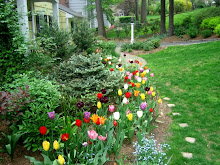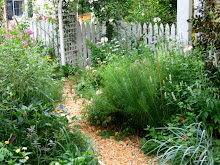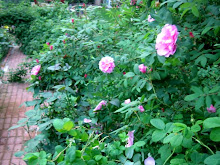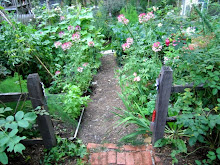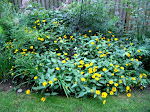 I saw a tiny (about an inch and a half across) little butterfly that I had never seen in my garden before. As you can see in the picture, she is all black with a distinctive yellow band on her wings. Looking at my butterfly books, she appears to be a Golden-banded Skipper. In flight, given the rapid fluttering and an erratic flight pattern, the yellow band almost looks like a vibrating circle. She didn't stay still for very long, so was happy that I was able to dash back into the house, grab my camera, and snap this one picture before she said goodbye.
I saw a tiny (about an inch and a half across) little butterfly that I had never seen in my garden before. As you can see in the picture, she is all black with a distinctive yellow band on her wings. Looking at my butterfly books, she appears to be a Golden-banded Skipper. In flight, given the rapid fluttering and an erratic flight pattern, the yellow band almost looks like a vibrating circle. She didn't stay still for very long, so was happy that I was able to dash back into the house, grab my camera, and snap this one picture before she said goodbye.
Welcome to Heirloom Gardener
Saturday, May 31, 2008
Picture of a Golden-banded Skipper (Autochton cellus) on Jewel Weed (Impatiens capensis)
Posted by
Julia Erickson
at
11:51 PM
3
comments
![]()
![]()
Labels: Wildlife in the Garden
Container Gardening: Summer Containers
Posted by
Julia Erickson
at
10:13 PM
1 comments
![]()
![]()
Labels: Container Gardening, Summer Garden
Thursday, May 29, 2008
How to See Beautiful Private Gardens: The Garden Conservancy's Open Days
As a follow-up to my prior post about the Garden Conservancy, I was excited to read about their upcoming Open Days. Valerie Sudol of the Star-Ledger writes:
"The Open Days program kicks off on May 31 in New Jersey, when a garden in Somerset County and another in Hunterdon County throw open the gates to visitors.
River Run Farm in Bedminster is a horse farm estate dating to the 1920s, with formal gardens designed in 1980 by John Smith. These include a walled pool garden, a wisteria-draped gazebo, woodland and courtyard gardens, and a vast collection of shade-loving plants.
Woodlove, a garden in Glen Gardner, was created over a 30-year period and includes perennial gardens, collections of fern and hosta species, and a stream terminating in a frog pond. The six-acre property has been divided into "garden rooms," each with its own character.
The Open Days program continues through Sept. 6, with visits scheduled to gardens in Essex, Bergen and Union counties."
Hopefully, when we're not going to ballet or baseball, we can make some of the ones in New Jersey. They are also taking place in California, Connecticut, Florida, Illinois, Kentucky, Maine, Massachusetts, New York, North Carolina, Oregon, Pennsylvania, Tennessee, Texas, and Washington. For the complete schedule, check out the Garden Conservancy's website.
Posted by
Julia Erickson
at
11:01 AM
1 comments
![]()
![]()
Wednesday, May 28, 2008
A Wonderful Day Trip to Well-Sweep Herb Farm in Port Murray, New Jersey
Heirloom plants, especially non-culinary herbs and plants of the American prairie, run throughout my garden. This weekend I found some wonderful new additions at Well-Sweep Herb Farm in Port Murray, New Jersey, about an hour away from Chatham. For a while, this has been on my most-wanted-to-visit list of nurseries. Boy, what a treat it was.
~
The setting of the nursery is beautiful. It's four acres, surrounded by over 100 acres of undeveloped land. The parking lot is a grass field. Sheep graze along the periphery. An informal herb garden meets you as you get out of your car, then there are plants for sale, the gift shop, and a formal herb garden. It was a treat to talk to Cy who started the nursery forty years ago. He knew each plant's history, how to use it, and cultural information that only comes from years of experience.
~
I was amazed by the breath of the collection. One of my favorite herbs is rue. Well Sweep had at least seven varieties from which to choose. I didn't even know there was such variation in rue. As for thyme, there are over 100 varieties for sale. If you can't get to the Herb Farm, plants are described and available in their mail order catalog which is available on their website:
~
"...In 1966, husband and wife, Cyrus and Louise Hyde, purchased an old run-down house and a piece of property. With a background in farming and a passion for gardening, what began as a homestead gradually transformed and grew into a national attraction...Our farm, a family endeavor...is home to one of the largest collections of herbs and perennials in the country...Our butterfly, herb, medicinal, perennial and rock gardens burst forth with breathtaking displays throughout the farm and have been featured in national magazines and books. Our brick-pathed formal herb garden boasts a knot garden, as well as a display of the 37 basils, 75 lavenders, 54 rosemarys, 108 thymes, and 72 scented-leaf geranium varieties that we stock. Whether for pleasure, inspiration, or ideas ... come see the possibilities..."
~
On a side note: those native orange rocks that I was recently posting about,Cy has cleared all of them and used them to make large, attractive walls. Next time, I'll bring my camera.
Posted by
Julia Erickson
at
8:44 AM
3
comments
![]()
![]()
Labels: Heirloom and Organic Food, New Jersey / Local Interest, Nurseries
Saturday, May 24, 2008
Vegetable Gardening with Children: How to Plant Corn with Fish the Way Squanto Taught the Pilgrims

~
There is a well-known and amazing story about how Squanto--the Native American captured and sold into and escaped from European slavery--befriended and taught the bewildered and hungry English pilgrims how to plant corn using fish as fertilizer, which was later harvested and eaten at the first Thanksgiving.
~
Inspired by this story, we used whole fish as fertilizer last year, which worked quite well, and repeated it again this year as follows:
~
1. Catch (or buy) some fresh whole fish.
2. Dig a hole several inches deep and add your fish.
3. Plant your kernels (or seedlings) on top of the fish.
~
Related posts: Ten Tips for Planning a Children's Garden, How to Build Raised Vegetable Beds, Organically Preparing the Soil for Planting
Posted by
Julia Erickson
at
8:53 AM
5
comments
![]()
![]()
Thursday, May 22, 2008
Garden Bloggers' Design Workshop: Stone in the Garden
I love stone in the garden. It is the perfect complement to all of my plants. As a part of this month's Garden Bloggers' Design Workshop over at Gardening Gone Wild, here is a brief post about how I have slowly replaced man-made materials with stone throughout my garden.
~
~
 2. The Pebble Path. I love pebble paths, but it is difficult to have them when you live and garden on a slope, as I do.
2. The Pebble Path. I love pebble paths, but it is difficult to have them when you live and garden on a slope, as I do.~
 3. The Dry Laid Walls of Native Stones. If you have ever visited my region of New Jersey, you will see orange rocks everywhere: on the sides of the road, on the edges of properties, and even on the edges of garden beds. Every time I try to dig a hole, they are waiting for me: small, medium, large, and even giant-sized orange rocks. And unlike those beautiful, grey rocks that can be handsomely stacked into walls, these rocks are so unshapely that it's impossible to dry lay them more than one or two layers high, which is exactly what I did to create the walls in my Walled Garden.
3. The Dry Laid Walls of Native Stones. If you have ever visited my region of New Jersey, you will see orange rocks everywhere: on the sides of the road, on the edges of properties, and even on the edges of garden beds. Every time I try to dig a hole, they are waiting for me: small, medium, large, and even giant-sized orange rocks. And unlike those beautiful, grey rocks that can be handsomely stacked into walls, these rocks are so unshapely that it's impossible to dry lay them more than one or two layers high, which is exactly what I did to create the walls in my Walled Garden.
Posted by
Julia Erickson
at
9:42 PM
6
comments
![]()
![]()
Labels: Fences Arbors Walls and Paths, Garden Bloggers' Design Workshop
Tuesday, May 20, 2008
Mad for Cranesbill Geraniums: Where to Plant, How to Maintain, Where to Buy

~
~
~
 Where to Buy Cranesbill Geraniums. My first geraniums were from Perennial Pleasures Nursery which specializes in heirloom perennials. I also got others from Heronswood before they were sold. Another wonderful source for hardy geraniums is Geraniaceae, a California nursery which also has an online catalog. The selection at Geraniaceae is phenomenal. I am wanting to get some more mourning widow geraniums. Geraniaceae offers 26 different varieties. I don't know how I will be able to choose. I think this will be a paralysis of choice.
Where to Buy Cranesbill Geraniums. My first geraniums were from Perennial Pleasures Nursery which specializes in heirloom perennials. I also got others from Heronswood before they were sold. Another wonderful source for hardy geraniums is Geraniaceae, a California nursery which also has an online catalog. The selection at Geraniaceae is phenomenal. I am wanting to get some more mourning widow geraniums. Geraniaceae offers 26 different varieties. I don't know how I will be able to choose. I think this will be a paralysis of choice.
Posted by
Julia Erickson
at
6:21 PM
1 comments
![]()
![]()
Sunday, May 18, 2008
Container Gardening: Pictures of Miss Kim Lilac

Posted by
Julia Erickson
at
8:43 PM
1 comments
![]()
![]()
Labels: Container Gardening, Shrubs
Butterflies in the Garden: Picture of a Painted Lady (Vanessa cardui) on an Allium
Posted by
Julia Erickson
at
10:32 AM
1 comments
![]()
![]()
Labels: Wildlife in the Garden
Saturday, May 17, 2008
Pictures from my Mothers' Day Visit to Reeves-Reed Arboretum in Summit, New Jersey
 Reeves-Reed Arboretum is one of my favorite botanical gardens (click on any images for the full picture).
Reeves-Reed Arboretum is one of my favorite botanical gardens (click on any images for the full picture). While Chanticleer and Wave Hill are ever-inspiring, Reeves-Reed and Willowwood Arboretum have the benefit of being local.
While Chanticleer and Wave Hill are ever-inspiring, Reeves-Reed and Willowwood Arboretum have the benefit of being local. Being only ten minutes away from Chatham in Summit, New Jersey, I get to visit Reeves-Reed frequently to see what's new.
Being only ten minutes away from Chatham in Summit, New Jersey, I get to visit Reeves-Reed frequently to see what's new. Further, being in my identical gardening zone (6b), I know it will work in my garden if it works at Reeves-Reed.
Further, being in my identical gardening zone (6b), I know it will work in my garden if it works at Reeves-Reed. Also, being of a more modest scale, they have a lot that is applicable to the home gardener.
Also, being of a more modest scale, they have a lot that is applicable to the home gardener.
From the website: "The Reeves-Reed Arboretum is a suburban conservancy dedicated to environmental and horticultural education for children and adults...
"The Reeves-Reed Arboretum is a suburban conservancy dedicated to environmental and horticultural education for children and adults... and to the enjoyment of nature through the professional care and preservation of a historic country estate. Reeves-Reed Arboretum has 5-1/2 acres of formal gardens.
and to the enjoyment of nature through the professional care and preservation of a historic country estate. Reeves-Reed Arboretum has 5-1/2 acres of formal gardens. The gardens represent design trends of the early 20th century.
The gardens represent design trends of the early 20th century. A map of the Arboretum grounds and description of the grounds are available.
A map of the Arboretum grounds and description of the grounds are available. Also we have a wildflower guide depicting some of the many flowers that can be found at Reeves-Reed Arboretum."
Also we have a wildflower guide depicting some of the many flowers that can be found at Reeves-Reed Arboretum." Related posts: Living and Gardening Around Chatham, New Jersey, A Visit to Chanticleer in Wayne, Pennsylvania
Related posts: Living and Gardening Around Chatham, New Jersey, A Visit to Chanticleer in Wayne, Pennsylvania
Posted by
Julia Erickson
at
9:56 PM
3
comments
![]()
![]()
Wednesday, May 14, 2008
Garden Bloggers' Bloom Day - May 2008: Roses, Daffodils, Peonies, Lilacs, Irises, Alliums, and Mountain Bluet in New Jersey (zone 6b)
May and June are probably my favorite garden months. I love how they hint at the abundance to come in late summer, not to mention the old fashioned roses are blooming then. Here are just some of the highlights for May's bloom day (double click on any image for the full picture).
 Frau Dagmar Hastrup, and then Rouletti, are my first roses of the season. Frau Dagmar is wonderful for its heavy scent and continuous bloom.
Frau Dagmar Hastrup, and then Rouletti, are my first roses of the season. Frau Dagmar is wonderful for its heavy scent and continuous bloom.  My last daffodils to open are the Peasant Eye. Sadly, they signal the end of daffodil season. These too are fragrant.
My last daffodils to open are the Peasant Eye. Sadly, they signal the end of daffodil season. These too are fragrant. This tree peony is young, so I only get a few blooms, but they are spectacular. Each bloom is about eight inches across. The tree peonies have been holding their blooms surprisingly well this season despite the rain.
This tree peony is young, so I only get a few blooms, but they are spectacular. Each bloom is about eight inches across. The tree peonies have been holding their blooms surprisingly well this season despite the rain.~
 With huge blooms this wonderfully fragrant lilac, Nadezhda, is a highlight of the lilac season.
With huge blooms this wonderfully fragrant lilac, Nadezhda, is a highlight of the lilac season.~
 Camassias and irises blooming in the Triangle Garden.
Camassias and irises blooming in the Triangle Garden.~
 I love the purple allium aflatunenses. These have self seeded throughout the front garden.
I love the purple allium aflatunenses. These have self seeded throughout the front garden.~
Posted by
Julia Erickson
at
10:15 PM
7
comments
![]()
![]()
Labels: Cut and Forced Flowers, Garden Bloggers' Bloom Day, Spring Garden
Tuesday, May 13, 2008
Gardening with Children: How to Make a Crown and Boutonniere with Fresh Flowers
 Last Saturday, two of my children made their First Communion. As a part of the joyous celebration, I made a crown for my daughter and a boutonniere for my son using fresh flowers from my garden. They were easy to make and could also be used for weddings (the perfect touch for a flower girl or ring bearer) and other special events of the summer.
Last Saturday, two of my children made their First Communion. As a part of the joyous celebration, I made a crown for my daughter and a boutonniere for my son using fresh flowers from my garden. They were easy to make and could also be used for weddings (the perfect touch for a flower girl or ring bearer) and other special events of the summer.
 1. The base of the crown. As a base, I made ring out of a long, flexible branch from a weigelia. I bound the ends together with floral wire and tape. You could also use a young branch from forsythia, spirea, or honeysuckle.
1. The base of the crown. As a base, I made ring out of a long, flexible branch from a weigelia. I bound the ends together with floral wire and tape. You could also use a young branch from forsythia, spirea, or honeysuckle. 2. The flowers for the crown. Then, I went out to collect fresh flowers from my garden. I looked for flowers that were not too big and would last well out of water. Also, I took many fragrant flowers. I collected the following: daffodils, honeysuckle, brunnera, muscari, bluebells, dogwood, daphne, forget me nots, and cherry blossoms.
2. The flowers for the crown. Then, I went out to collect fresh flowers from my garden. I looked for flowers that were not too big and would last well out of water. Also, I took many fragrant flowers. I collected the following: daffodils, honeysuckle, brunnera, muscari, bluebells, dogwood, daphne, forget me nots, and cherry blossoms. 3. Attaching the flowers to the base. With floral wire, I attached each flower to the weigelia base.
3. Attaching the flowers to the base. With floral wire, I attached each flower to the weigelia base. 4. The finished product. When it was done, I spritzed the crown with water and put it into the refrigerator until we were ready to put it on.
4. The finished product. When it was done, I spritzed the crown with water and put it into the refrigerator until we were ready to put it on. For the boutonniere, I used a brunnera leaf as the backing and wrapped daffodils and brunnera flowers together. I secured the whole thing together with floral tape and put it into the refrigerator to wait. The boutonniere was lovely, but I would not use brunnear foliae again because it wilts very quickly out of water (see picture); an immature hosta leaf would have been better.
For the boutonniere, I used a brunnera leaf as the backing and wrapped daffodils and brunnera flowers together. I secured the whole thing together with floral tape and put it into the refrigerator to wait. The boutonniere was lovely, but I would not use brunnear foliae again because it wilts very quickly out of water (see picture); an immature hosta leaf would have been better.
Posted by
Julia Erickson
at
10:52 PM
5
comments
![]()
![]()
Sunday, May 11, 2008
Birds in the Garden: Picture of a Tufted Titmouse Nest
 April 29, 2008: Recently, I noticed some birds flying in and out of the children's playhouse. Upon closer observation, it appears that a pair of tufted titmouses or titmice have built a nest in the framing of the fort against the wall. Interestingly, the nest is oriented horizontally, not vertically, as I am used to seeing in a tree. My husband took this picture head-on (not top-down) without a flash last weekend, but we haven't been back in recently to avoid disturbing them.
April 29, 2008: Recently, I noticed some birds flying in and out of the children's playhouse. Upon closer observation, it appears that a pair of tufted titmouses or titmice have built a nest in the framing of the fort against the wall. Interestingly, the nest is oriented horizontally, not vertically, as I am used to seeing in a tree. My husband took this picture head-on (not top-down) without a flash last weekend, but we haven't been back in recently to avoid disturbing them.
Posted by
Julia Erickson
at
11:40 AM
2
comments
![]()
![]()
Labels: Wildlife in the Garden
Saturday, May 10, 2008
Old Farmer's Almanac Spring Planting Schedule (May)
 As I wrote in my prior posts on my April planting schedule and heirloom seed sources and potato planting and asparagus harvesting, I am following the Old Farmer's Almanac Gardening 2008 Calendar this year. As a a relatively new vegetable gardener (most of my gardening experience is as a flower gardener), the Calendar is an indispensable help in knowing when to plant what.
As I wrote in my prior posts on my April planting schedule and heirloom seed sources and potato planting and asparagus harvesting, I am following the Old Farmer's Almanac Gardening 2008 Calendar this year. As a a relatively new vegetable gardener (most of my gardening experience is as a flower gardener), the Calendar is an indispensable help in knowing when to plant what.
~
*Asparagus - planted three years ago, the first harvest was two weeks ago, the second harvest was last week, and the third harvest will be in the coming week; I love perennial vegetables
 *Brocolli Rabe (pictured) - seedlings planted in early April were harvested last week and were delicious
*Brocolli Rabe (pictured) - seedlings planted in early April were harvested last week and were delicious*Lettuce, Swiss Chard, Carrots, Leeks, Beets, Onions, and Sugar Snap Peas - also planted in early April, but not yet ready to harvest
 *Potatoes (pictured) - seed potatoes planted two weeks ago have already started to come up--I just bought the salt hay to cover them this week
*Potatoes (pictured) - seed potatoes planted two weeks ago have already started to come up--I just bought the salt hay to cover them this week*Tomatoes, Zucchini, Cucumbers, Eggplant, Pumpkins, and Watermelon - some were planted last week, the rest will be planted this week
*Corn - to be planted this week Native American-style with a piece of whole fish for each seedling--this is another great project with the kids, though you have to harvest all of the ears the minute they are ready before the critters get to them
Posted by
Julia Erickson
at
11:49 PM
1 comments
![]()
![]()
Labels: Heirloom and Organic Food
Friday, May 09, 2008
What I've Learned About Growing Tulips in New Jersey: Protecting from Squirrels and Deer, Planting in Clay Soil, and Creating Colorful Combinations
 One of my favorite spring flowers at this time of year is the tulip. Because of the squirrels, deer, and clay soil in my area of New Jersey, few of my neighbors grow tulips, but it can be done. Here are some lessons that I have learned over the past few years on growing these beautiful flowers in my less than ideal conditions. For me, it has been well worth the effort.
One of my favorite spring flowers at this time of year is the tulip. Because of the squirrels, deer, and clay soil in my area of New Jersey, few of my neighbors grow tulips, but it can be done. Here are some lessons that I have learned over the past few years on growing these beautiful flowers in my less than ideal conditions. For me, it has been well worth the effort.
~
 In contrast, the heirloom varieties are much more tolerant of my less-than-ideal clay soil. I find that about three-quarters of them will survive the summers in the ground. In the areas where I grow them, like the Rose Garden (pictured), I simply plant enough new bulbs each fall to compensate for the expected loss. A mix of orange tulips including General de Wet, Orange Favorite, Princess Irene, Dillenberg are planted with Black Parrot as a dark purple accent.
In contrast, the heirloom varieties are much more tolerant of my less-than-ideal clay soil. I find that about three-quarters of them will survive the summers in the ground. In the areas where I grow them, like the Rose Garden (pictured), I simply plant enough new bulbs each fall to compensate for the expected loss. A mix of orange tulips including General de Wet, Orange Favorite, Princess Irene, Dillenberg are planted with Black Parrot as a dark purple accent. 
 3. Creating Colorful Combinations of Tulips. Inspired by the Granny Mix offered by Old House Gardens, the last two years I've been mixing up my own tulip combinations to remind me of the old mixtures found in cottage gardens or old time front door gardens. I have ten varieties of tulips chosen for a range of color, height, and form which bloom April and May. My own mix is planted in the front of our house (pictured). It consist of the following tulips: Ballerina, Queen of the Night, Couleur Cardinal, Princess Irene, Kingsblood, Mariette Cum Laude, Maureen, Mrs John T. Scheepers, and Dordogne.
3. Creating Colorful Combinations of Tulips. Inspired by the Granny Mix offered by Old House Gardens, the last two years I've been mixing up my own tulip combinations to remind me of the old mixtures found in cottage gardens or old time front door gardens. I have ten varieties of tulips chosen for a range of color, height, and form which bloom April and May. My own mix is planted in the front of our house (pictured). It consist of the following tulips: Ballerina, Queen of the Night, Couleur Cardinal, Princess Irene, Kingsblood, Mariette Cum Laude, Maureen, Mrs John T. Scheepers, and Dordogne.
 Under a pink flowering crabapple outside the Children's Garden, I planted Christmas Dream, Big Smile and Menton. I must say that originally, I did not like the apricot color of Menton, but as it matures it is absolutely beautiful, particularly because it picks up tones in the red foliage of the crabapple as the leaves elongate.
Under a pink flowering crabapple outside the Children's Garden, I planted Christmas Dream, Big Smile and Menton. I must say that originally, I did not like the apricot color of Menton, but as it matures it is absolutely beautiful, particularly because it picks up tones in the red foliage of the crabapple as the leaves elongate.  On Lilac Hill, I planted the String of Pearls combination from White Flower Farm along with Lilac Perfection, Monte Carlo, Blue Diamond, and Violet Beauty. The String of Pearls collection contains Mount Tacoma, Maureen, White Triumphator, Spring Green, and Calgary.
On Lilac Hill, I planted the String of Pearls combination from White Flower Farm along with Lilac Perfection, Monte Carlo, Blue Diamond, and Violet Beauty. The String of Pearls collection contains Mount Tacoma, Maureen, White Triumphator, Spring Green, and Calgary.
Posted by
Julia Erickson
at
10:34 PM
10
comments
![]()
![]()
Labels: Bulbs and Tubers, Cut and Forced Flowers, Pest Control, Spring Garden
Search Heirloom Gardener
Labels
- About Blogging
- Annuals/Biennials and Perennials
- Autumn Garden
- Books and Movies
- Botanical Gardens
- Bulbs and Tubers
- Children's Garden
- Chrysanthemum
- Clematis
- Container Gardening
- Crocus tommasiniasus roseus
- Cut and Forced Flowers
- Cutting and Rose Gardens
- Dahlias
- Deep Thoughts About Gardening
- Egg Garden
- Fences Arbors Walls and Paths
- Floral arrangements
- Front Border
- Fun Stories About Gardening
- Garden Bloggers' Bloom Day
- Garden Bloggers' Design Workshop
- Garden Planning
- Gardening Blogs
- Gardening Tools and Structures
- Gardening with Children
- Goldberry Hill
- Heirloom and Organic Food
- Hibiscus
- Holidays
- Hydrangeas
- Japanese Beautyberry
- Lilies
- Mixed Borders
- New Jersey / Local Interest
- Nurseries
- Online Gardening Resources
- Peonies
- Pest Control
- Picture This Photo Contest
- Piet Oudolf
- Poppies
- Propagation and Seeds
- Pruning and Maintenance
- Roses
- Seed Heads
- Self Seeders
- Shrubs
- Spring Garden
- Summer Garden
- Trees
- Wildlife in the Garden
- Winter Garden
- Zinia
Blog Archive
-
▼
2008
(202)
-
▼
May
(18)
- Picture of a Golden-banded Skipper (Autochton cell...
- Container Gardening: Summer Containers
- How to See Beautiful Private Gardens: The Garden ...
- A Wonderful Day Trip to Well-Sweep Herb Farm in Po...
- Vegetable Gardening with Children: How to Plant C...
- Garden Bloggers' Design Workshop: Stone in the Ga...
- Mad for Cranesbill Geraniums: Where to Plant, How...
- Container Gardening: Pictures of Miss Kim Lilac
- Butterflies in the Garden: Picture of a Painted L...
- Pictures from my Mothers' Day Visit to Reeves-Reed...
- Garden Bloggers' Bloom Day - May 2008: Roses, Daf...
- Gardening with Children: How to Make a Crown and ...
- Birds in the Garden: Picture of a Tufted Titmouse...
- Old Farmer's Almanac Spring Planting Schedule (May)
- What I've Learned About Growing Tulips in New Jers...
- Spring Ephemerals: Virginia Bluebells Are Spreadi...
- Advice Wanted: Crown Imperial Fritillaria Coming ...
- Vegetable Gardening with Children: How to Plant P...
-
▼
May
(18)




















